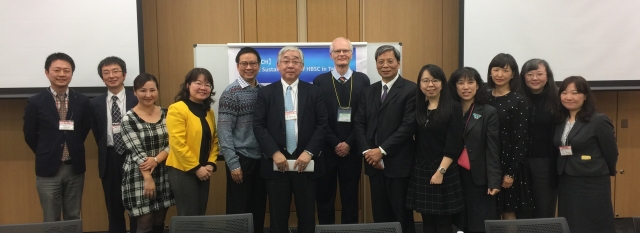
Faculty of the meeting with the Taiwanese delegation
I was in Tokyo recently to speak at an international meeting to commemorate the 15th anniversary of the Japan Association for Healthcare Balanced Scorecard Studies. Yes, the Japanese are very serious about performance tracking and use of management tools to uplift and improve.
Prof Toshiro Takahashi, President of the Association and Prof Daisuke Koide, Chair of the Host Committee were wonderful hosts and I learnt much from them and the other faculty.
My role was to share the Singapore experience with BSC in healthcare and I made the following points:
- Constant change and modifications– BSC, and more generally performance measurement are dynamic tools and should be considered as ‘Work in Progress’ with ongoing reviews and revisions as experience deepens; besides healthcare delivery changes due to technological advancement, financing model evolution, patient expectations and so on. Hence we should expect the metrics in the BSC to change over time. I had recommended a Pareto type pace of change with 80% of the metrics constant for any given time period and the remaining 20% with modifications permitted
- Healthy tension across KPIs– The metrics in the BSC should be in dynamic tension, allowing managers to trade-off between Key Performance Indicators (KPIs) depending on the specifics of each case. For example, public hospitals should be focused on patients and not profits, and yet also need to be financially sustainable. Metrics on patient experience, waiting times and outcomes thus are pitted to some degree with those on financial viability and fiscal prudence. This is inevitable and we should welcome the in-built ability of the BSC to make these trade-offs explicit.
- Cascade and Align– BSCs for national health systems should cascade from national objectives all the way through healthcare groups and hospitals to the operating units. Line managers must see how their KPIs align to the organizational BSC and the logic of how KPIs ‘flow’ from one BSC to another and relate to each other should be irrefutable
- Benchmarking– We in healthcare tend to over-estimate how ‘unique’ our situation is and the need for bespoke solutions for every patient and every circumstance. However much of what we can or at least facets of them can be benchmarked, and how these metrics compare against peers internally and externally are vital to help us improve
- Process of Change– As described above, the BSC should change with change in the external and internal environments. However, we should not trivialize introducing new KPIs which is anxiety-producing for managers and clinicians. This delicate process needs careful thought and the model the Singapore Ministry of Health (MOH) uses is worth further study. In this model, new metrics are progressed from ‘Development’ to ‘Monitoring’ to ‘Performance’ over a number of cycles. This allows for learning and for experience to be obtained before the metrics impact on bonuses and performance appraisals (‘Performance’ metrics in the Singapore model are tracked in the MOH-driven Service Level Agreement hospitals commit to and hold themselves accountable for, and has been useful for buy-in
- Enabling improvement– Ultimately, we track metrics to reassure ourselves of how we are doing and to identify gaps in performance which we can work on to improve. Healthcare data can be very complex and much of the data in a multi-echeloned health system originates from the institutions being monitored. The clear potential for false reporting is very real and savvy Corporate HQs know how to strike the right mix of carrots and sticks. Yes, some measure of penalties is needed for poor performance but providing resources from Corporate to enable improvements in business units for specific KPIs encourages honesty in reporting. The exact blend varies from institution to institution but astute leaders adroitly manage this fine balance.
It was very interesting to note the emphasis in Japan and Taiwan on ‘sustainability’ in healthcare and use of the BSC to reflect efforts to achieve the triple ‘bottom line’- financial performance, social benefits and minimizing of negative environmental impact. I was somewhat sheepish to admit that environmental impact was not on any of the Singapore healthcare organization BSCs I had studied although I made the point that driving efficiency naturally minimized waste and hence lowered adverse ecological effects. A bit feeble, yes, but I also shared the example of how the National Kidney Foundation, Singapore had donated refurbished dialysis machines to Fiji many years ago as part of the initiative to establish a Fijian dialysis program.
[Special thanks to the Ministry of Health Singapore, and a number of the Singapore public healthcare clusters that had generously shared data and their experiences during preparation for the presentations]